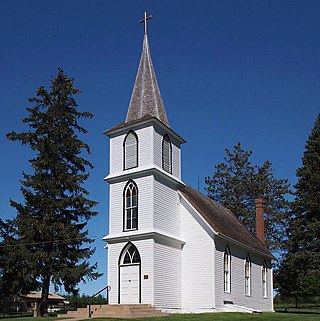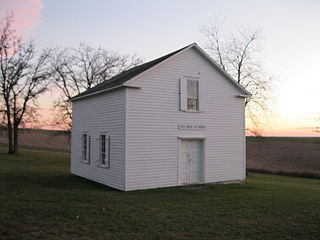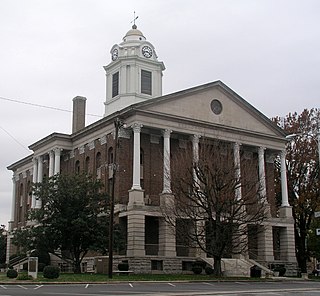
Schellsburg is a borough in Bedford County, Pennsylvania, United States. The population was 330 at the 2020 census.

Shelbyville is a city in and the county seat of Bedford County, Tennessee. The town was laid out in 1810 and incorporated in 1819. Shelbyville had a population of 20,335 residents at the 2010 census. The town is a hub of the Tennessee Walking Horse industry and has been nicknamed "The Walking Horse Capital of the World".

Lynchburg is a city in the south-central region of the U.S. state of Tennessee. It is governed by a consolidated city-county government unit whose boundaries coincide with those of Moore County. Lynchburg is best known as the location of Jack Daniel's distillery, whose famous Tennessee whiskey is marketed worldwide as the product of a city with only one traffic light. Despite the operational distillery, which is a major tourist attraction, Lynchburg's home county of Moore is a dry county. Sampling whiskey is permitted in the distillery, however. The population was 6,461 at the 2020 census.

Christdala Evangelical Swedish Lutheran Church is a historic church located in Forest Township, Rice County, Minnesota. It is situated 11 miles (18 km) west of Northfield at 4695 Millersburg Blvd.

Trinity Church, also known as Old Swedes' Church, is a historic church on the northwest corner of Church Street and King's Highway in Swedesboro in Gloucester County, New Jersey, U.S.

St. Paul's Church and Cemetery also known as Old St. Paul's Lutheran Church or St. Paul's Lutheran Church is a church in Newton, North Carolina. It was listed on the National Register of Historic Places in 1971 as a Historic Place in Catawba County, North Carolina.

Damascus Baptist Church Arbor is a historic Baptist church arbor located in Sharpesburg Township south of Love Valley, North Carolina, United States. It was constructed in 1855, and is an open rectangular structure measuring 35 feet by 55 feet. The Damascus Baptist Church Arbor continues to be used for brush arbor revivals. It has a gable-on-hip roof and hand hewn, pegged frame, log rafters. The arbor is part of a Damascus Baptist Church complex that includes a church, education building, and cemetery.

Jenkins Lutheran Chapel and Cemetery is a historic Lutheran church near Shelbyville, Tennessee.

Hackney Chapel AME Zion Church, also known as Unitia AME Zion Church, is a historic African-American church in rural Loudon County, Tennessee. The adjacent cemetery has about 100 marked graves and up to 200 unmarked graves. The church and cemetery were added to the National Register of Historic Places in 2000.

Old East Paint Creek Lutheran Church is located north of Waterville, Iowa, United States. The church building was listed on the National Register of Historic Places in 1983.

The Hauge Log Church is located near the community of Daleyville in the town of Perry, Wisconsin. It was the first Norwegian Lutheran Church constructed in western Wisconsin. Hauge Log Church is located on County Highway Z just off State Highway 78. The historic building was added to the National Register of Historic Places in 1974. A Historic District Park open year round was created by the residents of the Town of Perry in 2001 to surround and protect its scenic views and serenity from development in perpetuity.

The Painesville Chapel is a historic meeting hall built in 1852 by German immigrant Freethinkers in Franklin, Milwaukee County, Wisconsin. It was added to the National Register of Historic Places in 1977.

The Shelbyville Courthouse Square Historic District is a historic district in Shelbyville, Tennessee, centered on the Bedford County Courthouse Square.

Hebron Church is a mid-19th-century Lutheran church in Intermont, Hampshire County, in the U.S. state of West Virginia. Hebron Church was founded in 1786 by German settlers in the Cacapon River Valley, making it the first Lutheran church west of the Shenandoah Valley. The congregation worshiped in a log church, which initially served both Lutheran and Reformed denominations. Its congregation was originally German-speaking; the church's documents and religious services were in German until 1821, when records and sermons transitioned to English.

Son's Chapel is a historic church at 5480 East Mission in Fayetteville, Arkansas. It is a single-story rustic fieldstone structure, with front-gable roof and a squat square tower set off to one side. Built between 1933 and 1937, the building is an interesting and unusual mix of Gothic and Romanesque styles, with windows set under Romanesque arches, and the tower with a crenellated parapet. The church is the second for the congregation, which was established c. 1848 on land donated by Michael Son.

New Sweden Chapel is a historic Lutheran Church building located east of Fairfield, Iowa, United States in rural Jefferson County. The Swedish immigrant community that settled here was organized in 1845 under the leadership of Peter Cassel, a native of Kisa, Östergötland, Sweden. This was the first Swedish settlement in Iowa, as well as the first west of the Mississippi River. They established a Lutheran congregation in 1848, and built a log church in 1851. This church replaced it in 1860. Local builder Henri Jagle was responsible for building the 50-by-30-foot frame structure. It is four bays in length and features a 16-foot (4.9 m) tower with a spire over the main entrance. The interior features a painting by Olaf Grafström, who was an art instructor at Augustana College in Rock Island, Illinois. In 1948 the Augustana Evangelical Lutheran Church named the New Sweden Chapel as a National Synodial Shrine in recognition of its being the oldest congregation in the synod. Prince Bertil of Sweden and the Archbishop of Uppsala participated in a ceremony that drew 3,000 people. The chapel no longer houses a regular congregation, but is used for special occasions. A cemetery is located on the church grounds. The chapel was listed on the National Register of Historic Places in 1977.

West Paint Creek Synod Evangelical Lutheran Church and Cemetery is a historic building and site located northwest of Waterville, Iowa, United States. The church building and its adjacent cemetery were listed together on the National Register of Historic Places in 2019.

State Route 270, also known as Old Columbia Road, is a 9.5-mile-long (15.3 km) east–west state highway in Middle Tennessee. It connects Chapel Hill with Unionville and Shelbyville.

St. James Lutheran Church, also known as Straw Church, is a historic church built in 1834 and located at 1213 U.S. Route 22 in Pohatcong Township, Warren County, New Jersey. St. James Lutheran Cemetery is located across the street in Greenwich Township. The church and cemetery were added as a historic district to the National Register of Historic Places on October 24, 2016 for their significance in architecture and exploration/settlement. The adjoining building, Fellowship Hall, and the schoolhouse by the cemetery entrance are not part of this listing. The one-room brick schoolhouse, built 1858, is listed separately on the state register.





















